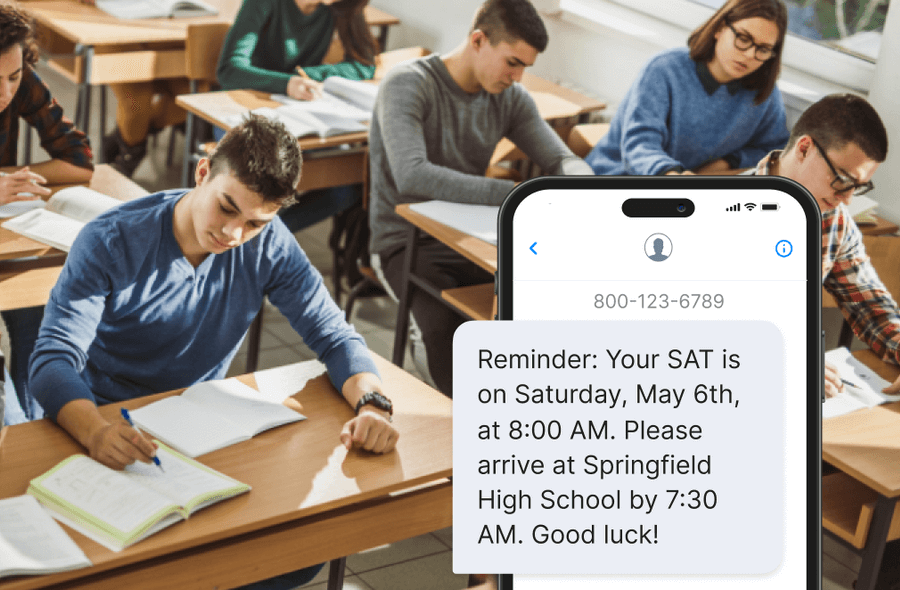📑 Table of Contents
- Define Objectives and Identify Your Audience
- Choose the Right SMS Messaging Platform
- Compliance and Consent – Ensuring Privacy and Legal Adherence
- Crafting an Effective SMS Content Strategy
- Segmenting Your Audience for Targeted Messaging
- Automating SMS for Efficient Communication
- Tracking, Measuring, and Optimizing SMS Campaigns
- Additional Tips for Success in SMS Messaging
Effective communication is essential for universities to keep students, faculty, and staff informed and engaged in the fast-paced digital world. Universities face the challenge of reaching a diverse and busy audience with important updates, deadlines, event notifications, and even emergency alerts. SMS messaging offers a direct and immediate communication channel, allowing universities to reach their audience in real-time.
Unlike email or social media, SMS messaging has an astounding 98% open rate, with most messages read within three minutes of receipt. This makes SMS a powerful tool for universities, especially when quick response and high visibility are needed.
This guide provides a comprehensive step-by-step approach to implementing SMS messaging for universities, ensuring high engagement and compliance.
Define Objectives and Identify Your Audience
Before diving into SMS messaging, universities should start by defining clear objectives for their communication. Setting specific goals helps guide the type of messages sent and ensures each message serves a purpose. A well-defined objective enhances the message’s relevance and helps maintain a positive student experience.
Importance of Defining Objectives
The first step in creating a successful SMS messaging strategy is understanding what the institution aims to achieve. Broadly, SMS messaging for universities may serve the following purposes:
- Student Reminders: Remind students about key deadlines, such as registration, tuition payment, or project submissions. Timely reminders help students stay on top of their responsibilities and can improve retention and academic success.
- Emergency Notifications: SMS messaging provides immediate, reliable communication in emergencies, such as severe weather, health alerts, or security incidents. Real-time updates can ensure students’ safety and well-being on campus.
- Event Notifications: Inform students about career fairs, guest lectures, workshops, and open houses. These messages can drive attendance, foster community engagement, and provide students valuable opportunities.
- Administrative Announcements: Keep students updated with administrative changes, policy updates, or academic calendar modifications. This improves transparency and keeps students informed about important changes within the university.
- Campus Resources: Inform students about available resources, such as tutoring services, health services, mental health counseling, or career support. The university fosters a more connected, supportive campus environment by regularly reminding students of available support.
- Student Engagement and Community Building: SMS can be a tool to engage students with motivational messages, academic tips, or community-building initiatives, creating a positive campus culture.
By defining these objectives, universities create a structured messaging approach that serves the needs of students, faculty, and staff. This also prevents message fatigue, as students only receive relevant information.
Identifying the Audience
Universities are complex organizations with multiple departments and various groups with distinct needs. When implementing SMS messaging, it’s crucial to identify different audience segments so that messages reach the right people at the right time. Here are some common groups to consider:
- Undergraduate and Graduate Students: Undergraduate students often have distinct needs compared to graduate students. For example, graduate students may benefit from research-related events, while undergraduates might be more interested in campus life events or general academic resources.
- Faculty and Staff: Faculty and staff require administrative updates, faculty meeting reminders, and resources for professional development. Including them in your SMS strategy keeps everyone on the same page and supports a unified campus environment.
- Parents and Guardians: Some universities include parents or guardians in specific messaging, such as financial aid reminders or important academic dates. This is especially useful for first-year students or younger undergraduates.
- Alumni: For alumni, SMS can provide updates about alumni events, fundraising campaigns, or volunteer opportunities, keeping them connected to the campus community.
- Special Interest Groups: Students involved in extracurricular activities, clubs, or organizations can benefit from targeted SMS messages about related events, meetings, or updates specific to their interests.
Actionable Tip: Develop a clear audience map that outlines each group, their communication needs, and the types of messages they should receive. This will help you craft more tailored content and ensure that SMS messaging is as relevant and effective as possible.
Choose the Right SMS Messaging Platform

Selecting an SMS messaging platform that fits a university’s needs is crucial to building an effective communication system. A robust platform should offer essential features and be adaptable to the university’s evolving needs. Factors like ease of use, scalability, compliance, and integration with existing systems are crucial in selecting a suitable platform.
Criteria for Selecting an SMS Platform
When evaluating SMS platforms, consider these key features that cater specifically to educational institutions:
- Segmentation Capabilities: Universities require the ability to send targeted messages to different groups, such as students by department, year, or extracurricular involvement. A platform with segmentation features allows for these tailored messages and reduces message fatigue among students.
- Automation and Scheduling: Automation helps send reminders, event notifications, and deadlines without requiring manual input each time. Scheduling capabilities also let administrators plan messages in advance, ensuring students receive timely reminders and updates.
- Two-Way Communication: Two-way SMS allows students to reply with questions, feedback, or specific responses. This feature is especially useful for support-related messages, event confirmations, or feedback surveys, creating a more interactive communication channel.
- Compliance and Security Features: Universities must adhere to strict privacy regulations, such as FERPA (Family Educational Rights and Privacy Act) and GDPR (General Data Protection Regulation). A compliant SMS platform should offer encryption, data access control, and clear options for opt-in and opt-out, which are crucial for protecting student data.
- Analytics and Reporting: Analytics allow universities to assess message performance, such as open rates, response rates, and opt-out rates. This data is valuable for refining SMS strategies over time and improving engagement.
- Integration with University Systems: Many universities rely on platforms like CRM, learning management systems (LMS), and student information systems (SIS). A compatible SMS platform should integrate with these systems to streamline communication, manage data efficiently, and reduce administrative overhead.
Comparative Analysis of Popular SMS Platforms for Universities
Different SMS platforms provide unique features that may cater to universities of varying sizes and needs. Here’s a look at some popular SMS platforms and their capabilities:
- Twilio: Known for its extensive API and customization options, Twilio is ideal for universities with specific integration needs. It offers scalable messaging solutions, two-way communication, and reliable data security features. However, Twilio may require technical support for setup and customization.
- EZ Texting: EZ Texting is user-friendly, making it a good choice for smaller institutions or universities looking for a straightforward SMS platform. It supports segmentation, scheduling, and automation, though it may have fewer advanced customization options than Twilio.
- Textedly: Textedly provides bulk messaging, detailed reporting, and robust automation features, making it a solid choice for universities with large audiences. The platform is known for its simplicity and scalability, though it may lack some niche educational features.
- SimpleTexting: This platform offers two-way messaging, segmentation, and analytics tailored to organizations that need a balance of simplicity and functionality. SimpleTexting is popular among universities looking for dependable support and easy integration with other systems.
Real-World Case Studies
- Case Study 1: A mid-sized university selected Twilio for its API flexibility, which allows integration with the institution’s student portal and LMS. By customizing Twilio, they achieved automated assignment reminders, seamless integration for event notifications, and a highly secure messaging environment suitable for FERPA and GDPR requirements.
- Case Study 2: A small liberal arts college opted for EZ Texting to keep messaging simple and effective. The platform’s ease of use allowed administrators to set up and launch a holiday event campaign within hours, increasing attendance by 20% through timely reminders and personalized messages.
Actionable Tip: When evaluating platforms, request a demo and check if the platform can handle the university’s specific messaging needs. Consider scalability, integration capability, and support quality to ensure long-term usability.
Compliance and Consent – Ensuring Privacy and Legal Adherence

Compliance with data protection and privacy regulations is paramount in any SMS messaging initiative, especially within universities. Universities must consider FERPA, GDPR, and TCPA requirements to protect students’ personal information and ensure transparent communication practices.
Understanding Compliance: FERPA, GDPR, and TCPA
- FERPA: The Family Educational Rights and Privacy Act is a federal law protecting students’ educational records. Universities must ensure that SMS platforms only share necessary information and maintain strict access control for student data.
- GDPR: The General Data Protection Regulation applies to students from the European Union and mandates that institutions obtain explicit consent before sending marketing or informational messages. GDPR also requires universities to provide options for data removal upon request.
- TCPA: The Telephone Consumer Protection Act in the United States mandates that universities must obtain clear opt-in consent from students before sending SMS messages. The act also provides students an easy opt-out process to manage communication preferences.
Step-by-Step Process for Gathering Consent
To ensure compliance, universities must develop a clear and transparent consent-gathering process. Here’s a step-by-step guide:
- Add an Opt-In Form During Registration: Include a simple opt-in form for SMS communication during student registration or orientation. Clearly explain the purpose of messaging and the types of information students can expect to receive.
- Provide Opt-Out Options: Every SMS should contain an opt-out option. Adding instructions like “Reply STOP to unsubscribe” typically meets compliance requirements and gives students control over their preferences.
- Maintain Consent Records: Keep a log of consent records, including when and how each student opted in. This record is essential for accountability and can serve as proof of compliance in case of an audit.
- Reconfirm Consent Periodically: Universities may periodically reconfirm consent, especially for students who haven’t interacted with SMS messages recently, to avoid potential legal issues.
Actionable Tip: Develop clear policies for opt-in and opt-out practices and regularly train staff on compliance standards. This practice can help protect the university from legal issues and maintain transparency with students.
Crafting an Effective SMS Content Strategy

An effective SMS content strategy is essential for engaging students and ensuring they receive valuable information without feeling overwhelmed. Crafting messages that are clear, concise, and relevant will keep students interested and reduce opt-out rates.
Guidelines for Writing SMS Messages
- Keep Messages Brief and Direct: SMS messages are limited to 160 characters, so every word matters. Use clear and direct language to convey the message without unnecessary jargon or filler.
- Front-Load Important Information: Place the most critical information at the beginning of the message. For instance, if it’s a registration reminder, start with “Reminder: Registration for the spring semester closes tomorrow.”
- Use a Friendly Tone: A warm and approachable tone can make messages more appealing. Avoid sounding overly formal or impersonal, especially for non-emergency messages.
- Add a Clear Call to Action: Each SMS should guide students to take a specific action, such as “Register now,” “Check your email,” or “Reply YES to confirm.” This approach improves engagement and helps students know exactly what to do next.
- Avoid Overloading Students: Sending too many SMS messages can cause students to tune out or unsubscribe. Ensure each message is necessary and adds value, especially during busy times like finals week.
Examples of Effective SMS Messages for Universities
- Deadline Reminder: “Reminder: The last day to register for the fall semester is tomorrow. Visit [link] to complete your registration.”
- Event Alert: “Join us for the Career Fair tomorrow at 10 AM in the Student Union. Meet employers and explore career opportunities!”
- Emergency Notification: “Campus closed today due to severe weather. Stay safe and check your email for updates.”
- Resource Highlight: “Need help with finals? Check out free tutoring services available this week in the library.”
Actionable Tip: Regularly test different types of messages and review engagement metrics to see what works best with students. Adjust your approach based on feedback and performance.
Segmenting Your Audience for Targeted Messaging

Audience segmentation is key to providing students with relevant information without overwhelming them. By dividing students into groups based on their academic year, program, or other criteria, universities can ensure messages reach the right people at the right time.
Benefits of Segmented Messaging
Segmenting your audience allows for more personalized communication, which is critical for engagement. Sending targeted messages based on students’ interests, academic level, or program helps avoid generic messaging and creates a more impactful experience.
- Academic Level Segmentation: Group students by educational level (e.g., freshmen, sophomores, graduates) to send tailored messages. For example, freshmen may receive notifications about orientation, while seniors receive graduation-related updates.
- Program or Major-Based Segmentation: Segmenting by major or department allows universities to send department-specific updates, such as application deadlines, relevant events, or course announcements.
- Residential vs. Commuter Students: Residential students may benefit from updates about campus housing, meal plans, and residence hall events. Commuters might receive information on parking permits, off-campus housing, or commuting resources.
- Extracurricular Involvement: Send messages to students participating in clubs, sports teams, or organizations about related events, meetings, and opportunities.
Examples of Segmented Messaging in Action
- Freshmen: “Welcome, Freshmen! Don’t forget that orientation is next Monday at 9 AM. Check your email for details.”
- Engineering Students: “Reminder for Engineering Majors: Project submission deadline is Friday at 5 PM. Submit your work on the portal.”
- Residential Students: “Important: Residence halls close for winter break on Dec 18 at noon. Make sure to check out by this time.”
Actionable Tip: Use your SMS platform’s segmentation tools to create relevant groups and streamline messaging. This allows you to send more relevant messages to each segment’s interests and needs.
Automating SMS for Efficient Communication

Automation is vital in managing university SMS communication, especially when handling routine notifications and reminders. With automated workflows, universities can streamline communication, ensuring that messages are sent consistently and at the right times. Automation reduces the administrative workload and helps ensure timely information delivery to students, faculty, and staff.
Benefits of Automation in SMS Messaging
- Time Savings: Automated SMS workflows save time for university staff by eliminating the need for manual message scheduling. This allows teams to focus on other priorities while ensuring that essential messages reach students consistently.
- Increased Consistency: Automated messages guarantee that students receive timely reminders about deadlines, registration periods, and other recurring updates. Consistency helps students stay informed and minimizes the chances of missed deadlines.
- Improved Engagement: Students’ engagement increases When they receive relevant and timely messages. For instance, reminders about registration deadlines or event attendance can improve student participation rates and engagement with university resources.
Types of Automated SMS Messages
- Event Reminders: Automate reminders for events such as orientations, guest lectures, or workshops. Scheduling reminders at intervals (one week, one day, and one hour before the event) helps increase attendance.
- Deadline Notifications: Automate reminders for important deadlines, such as registration, tuition payment, and project submission dates. These reminders can prevent students from missing critical dates.
- Application Updates: For universities with application deadlines, automated reminders can keep students on track with submitting necessary documents or completing application requirements.
- Welcome Messages: At the beginning of the semester, send automated welcome messages to new students. This creates a warm, welcoming atmosphere and introduces students to available resources.
- Periodic Check-ins: Automated check-ins with students can be beneficial for tracking academic progress or offering support. For instance, universities can schedule check-ins during midterms to provide educational support resources.
How to Set Up Automated SMS Workflows
Setting up automation requires careful planning and a well-structured workflow. Here’s a step-by-step guide to creating effective automated SMS workflows:
- Identify Repetitive Tasks: Identify recurring messages, such as exam reminders, registration, or events. Choose messages that benefit from automation due to their time-sensitive nature.
- Define Triggers and Timing: Determine the triggers that initiate each message. For example, a new semester might trigger a welcome message to all new students. In contrast, an upcoming registration deadline could trigger reminders two weeks, one week, and one day before the deadline.
- Create Message Templates: Develop templates for each type of automated message. Templates should be flexible enough to adapt to different student groups or academic levels, making reusing them for various campaigns easy.
- Monitor and Adjust: Regularly monitor the performance of automated messages by tracking metrics like open rates and response rates. Based on this data, adjust timing, message content, or frequency to improve engagement.
Case Studies: Universities Using Automation Effectively
- Case Study 1: A large public university uses automated SMS reminders for registration deadlines. By setting up reminders two weeks, one week, and one day before the deadline, the university saw a 25% increase in on-time registrations, reducing administrative follow-up work significantly.
- Case Study 2: A private college implemented automated welcome messages for incoming freshmen. Upon registration, each student received a personalized message and a series of helpful resources about the campus. The result was higher engagement with orientation events and greater usage of student services among first-year students.
Actionable Tip: Start small by automating one or two types of messages, such as deadline reminders or event invitations. Once you see positive engagement, expand to include more workflows and create a comprehensive, automated communication system.
Tracking, Measuring, and Optimizing SMS Campaigns

Tracking and measuring SMS campaigns is essential for understanding what works and identifying areas for improvement. By analyzing key metrics, universities can refine their SMS strategies, tailor messages to student preferences, and maximize engagement.
Key Metrics to Track for SMS Effectiveness
- Open Rate: The open rate reflects how many recipients opened the message. Although SMS open rates are high, tracking them can provide insight into student engagement over time and highlight messages that generate the most interest.
- Click-Through Rate (CTR): For messages that include links (e.g., to event registrations or surveys), the click-through rate measures how many recipients clicked the link. This metric helps gauge the effectiveness of calls to action and message relevance.
- Opt-Out Rate: The opt-out rate shows how many students chose to unsubscribe from SMS messaging. A high opt-out rate may indicate that messages are too frequent or irrelevant to students’ needs.
- Response Rate: The response rate shows how many recipients replied to the message for two-way. This metric is particularly useful for interactive campaigns, such as event RSVPs or feedback surveys.
- Conversion Rate: The conversion rate measures how many recipients completed a desired action, such as registering for an event or submitting a form. High conversion rates indicate successful engagement, while lower rates suggest that messages need adjustment.
Using Metrics to Refine SMS Strategies
- Identify Patterns: By analyzing engagement metrics over time, universities can identify patterns, such as which types of messages receive the highest response or which days of the week yield the best engagement.
- Adjust Frequency and Timing: Based on open and opt-out rates, adjust the frequency and timing of messages. For instance, if students are more responsive to messages sent in the afternoon, consider scheduling messages for that time.
- Optimize Content: Test different calls to action, tones, and message lengths to see what resonates best with students. Use A/B testing for more precise content optimization.
- Focus on High-Value Campaigns: If certain campaigns consistently yield higher engagement, allocate more resources to these campaigns. For example, if reminders about career fairs have a high response rate, consider increasing promotional efforts for these events.
Example Adjustments Based on Data Insights
- Scenario: A university notices that the response rate for midterm check-in messages is lower than expected. After analyzing the message content and timing, they find that students prefer receiving these messages in the evening when they’re more available to respond.
- Adjustment: The university reschedules midterm check-ins for the evening, resulting in a 15% increase in responses and greater engagement with support resources.
Actionable Tip: Use your SMS platform’s analytics dashboard to review metrics regularly and evaluate each campaign’s performance. Make data-driven adjustments to improve message relevance, timing, and engagement.
Additional Tips for Success in SMS Messaging

Creating a successful SMS messaging strategy requires continuous refinement. Here are some additional tips for maximizing the impact of SMS messaging in a university setting:
- Balance Message Frequency: While SMS is highly effective, sending too many messages can lead to message fatigue. Aim to send messages that add value without overwhelming students. Consider consolidating messages to reduce frequency during peak times (e.g., the start of a semester).
- Respect Quiet Hours: Respecting students’ personal time is crucial. Schedule messages to arrive during appropriate hours, generally avoiding early mornings or late unless it’s an emergency. Maintaining a considerate schedule improves engagement and reduces opt-outs.
- Personalize When Possible: Small details, such as using students’ first names or tailoring messages to their academic interests, can make a big difference. Personalization fosters a sense of connection and shows students that your institution values them.
- Solicit Feedback: Occasionally, ask students for feedback on SMS messaging. A quick survey can provide valuable insights into student preferences and help you refine your approach. Questions might include preferences for message timing, frequency, or types of information they find most useful.
- Stay Updated on Compliance: Regulations around data privacy and SMS messaging are continuously evolving. Regularly review compliance guidelines to ensure your SMS practices adhere to FERPA, GDPR, TCPA, and other relevant regulations.
- Engage Across Channels: While SMS is powerful, integrating it with other communication channels (like email and social media) can create a cohesive and engaging student experience. Use SMS for urgent messages and reminders, while saving detailed information for email.
- Celebrate University Milestones: Use SMS to celebrate important milestones, such as holidays, commencement announcements, or student achievements. These messages foster school spirit and connect students to campus life more.
Actionable Tip: Evaluate your SMS strategy based on student feedback and engagement data. Refining your approach helps maintain high engagement rates and ensures students feel valued and connected.
Conclusion
Implementing SMS messaging for universities offers a direct, effective way to reach students and enhance campus communication. By following a structured approach—starting with clear objectives, selecting the right platform, ensuring compliance, and crafting engaging content—universities can establish an SMS system that keeps students informed, engaged, and supported.
Audience segmentation and automation provide additional efficiencies, ensuring students receive relevant information tailored to their needs. With regular tracking and analysis, universities can refine their SMS strategies, optimize engagement, and create a valuable communication channel that aligns with student preferences.
In a fast-paced, digital-driven world, SMS messaging is essential for universities. It fosters better engagement, communication, and community-building. Embrace SMS as a core component of your university’s communication strategy, and watch the benefits unfold as students connect with campus life in real-time.
Your university can build a trusted and impactful SMS communication system that enhances students’ overall educational experience by continually adapting and improving.
